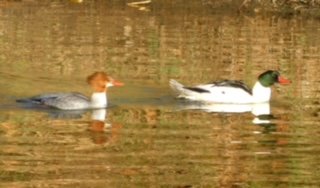Common Mergansers in the Little River!
One of the most interesting stories in the modern day world of Ornithology is playing out in our own backyard in the Little River Watershed! Commonly known as “saw-bills”, females of this very large duck species (Mergus merganser) have been observed with broods of ducklings along the Little River between Townsend and Walland since 2017 when local bird watchers first photographed a female with eight young from the old bridge near Walland. The attached photo was taken by Randy Winstead, an avid bird watcher and citizen scientist, who also resides on the Little River downstream of Coulters Bridge. Since 2017, Winstead has compiled over 142 eBird reports on Common Mergansers in Blount County! In 2020 it is believed that there were at least six successful broods raised on Little River which included at least two broods from the Metcalf Bottoms area in Sevier County. In June of 2022 Winstead observed a female with seven young on a rock in the river in front of his house which represents the farthest downstream successful breeding known to date. In addition to the Little River observations, Keith Watson from Pittman Center has observed a similar trend with breeding numbers on the Middle Prong of the Pigeon River in The Great Smoky Mountains National Park. Mr. Watson has documented his extensive findings in THE MIGRANT, which is published by the Tennessee Ornithological Society.
The documented breeding of Common Mergansers in these watershed areas is the first known from Tennessee since 1899! There is much speculation among those in the ornithological world about why this population expansion, or possible re-expansion is happening now. Is it associated with climate change? Or is it a response to the regrowth of forested riparian zones that were heavily logged for timber during the late 1800’s and early 1900’s which resulted in the severe degradation of these cold water stream habitats? As mentioned earlier, these are big ducks that are 25 inches long with a wingspan of 34 inches. They are known to be primarily cavity nesters similar to wood ducks. So have the riparian trees in these watersheds regrown to the size that can create a cavity large enough for these nesting females? Or have the streams' water quality and aquatic habitats improved to the point where they can support enough fish and other aquatic organisms that these birds depend on for food? And now for the biggest current mystery-no one to date has found an actual nest site yet! So while you are paddling or fishing the Little River early next spring be on the lookout for a female Common merganser sticking her head out of a tree cavity or possibly nesting on a rock bluff overhang or even on the ground adjacent to the River. You may actually help answer some questions about this ongoing Ornithological “mystery” right here in the Little River Watershed!
Many thanks to Wes James, a Little River Watershed Association board member and retired TVA Biologist for the write up!
All images are courtesy of Randy Winstead, a resident of Blount County and avid bird watcher.



